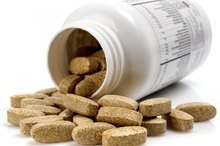Potassium & Magnesium Dosage
Potassium and magnesium are minerals required for the proper functioning of the cells and organs in your body. Eating a healthy diet rich in fruits, vegetables, whole grains and nuts will likely provide an adequate daily supply. Some conditions and treatments may cause low potassium and low magnesium levels, which require supplemental potassium and magnesium intake. Always check with your doctor before beginning supplemental treatment.
Potassium
One of the functions of potassium is as an electrolyte, necessary for heart function and muscle contraction. It works in conjunction with magnesium, calcium, sodium and chloride in conduction of electricity in your heart muscles. It is vital that you have the correct balance of potassium, since too much potassium can cause nausea, an irregular heartbeat and a slow or weak pulse. Too little potassium can cause fatigue, heart rhythm irregularities, constipation and muscle weakness.
Potassium Replacement
How Much Magnesium Per Day?
Learn More
Many potassium supplements are available as over-the-counter and prescription drugs in addition to the small amount found in multivitamins. The recommended daily intake for dietary potassium, according to the University of Maryland Medical Center, includes: 500 mg for birth to 6 months; 700 mg for infants 7 to 12 months; 1,000 mg for 1-year-old children; 1,400 mg for children ages 2 to 5; 1,600 mg for ages 6 to 9; and 2,000 mg for children over 10 years of age. The potassium requirement for adults, including pregnant and nursing women, is 2,000 mg.
Magnesium
The functions of magnesium in your body include the production of protein, muscle contraction and relaxation, and energy production and transport. A lack of magnesium can cause symptoms such as fatigue, muscle twitching, poor memory, confusion, rapid heartbeat, tingling, hallucinations and insomnia. Too much magnesium can cause symptoms such as nausea and vomiting, slow heart rate, confusion, extremely low blood pressure, coma and death.
Magnesium Replacement
Effects of Zinc With Potassium
Learn More
Available forms of magnesium, in addition to diet, include magnesium gluconate, magnesium citrate and magnesium lactate. For uses such as a laxative or antacid, sources include magnesium hydroxide and magnesium sulfate.
The recommended daily maximum magnesium supplement for children includes 80 mg for up to 3 years of age; 130 mg for children ages 4 to 8 years old; and 240 mg for ages 9 to 13; 410 mg for boys 14 to 18 years old; and 360 mg for girls 14 to 18 years old. Recommendations for adults include 310 mg to 320 mg for females; 350 mg to 400 mg if pregnant; 310 mg to 360 mg if breastfeeding; and 400 mg to 420 mg for males, according to Medline Plus.
Warning
Giving your child potassium or magnesium supplements without the direction of your doctor can be dangerous. The best source is from a well-balanced diet. Examples of food sources of magnesium include: 80 mg in 1 oz of dry roasted almonds; 75 mg in a half cup of frozen or cooked spinach; 45 mg in 8 oz of yogurt; and 30 mg in a medium banana.
Food sources of potassium include: 610 mg in one baked potato; 484 mg in one-half cup of cooked lima beans; 368 mg in one-fourth of a medium cantaloupe; and 355 mg in three-fourths cup of orange juice.
Related Articles
References
Resources
Writer Bio
Norene Anderson has been a writer since 2003. She is also a registered nurse with expertise in a wide range of medical conditions and treatments. Anderson received her associate degree in nursing from Lincoln University in Jefferson City, Mo.









